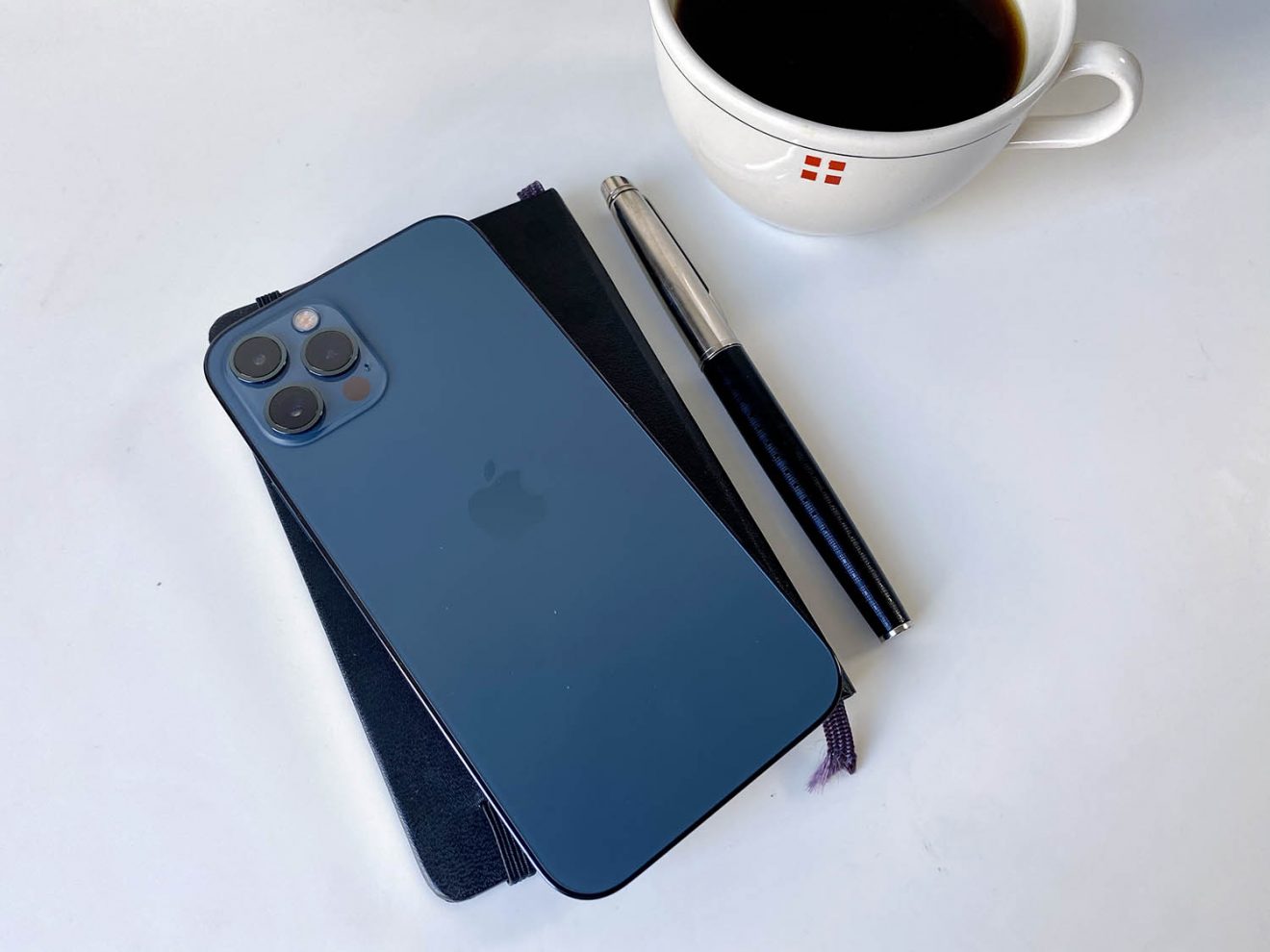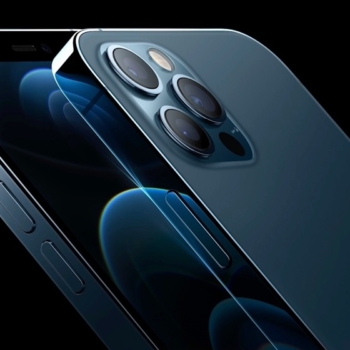
How do you like the iPhone 12 Pro, the latest high-end device from Apple? We have started testing and in this iPhone 12 Pro review you can read our experiences!
Introduction
Here it is, the first iPhone with 5G! Yet all attention seems to be mainly focused on all kinds of other things, such as the new appearance, the MagSafe accessories and the many new camera functions. Rightly so, we think. Because the iPhone 12 Pro has much more to offer than 5G. You also get an extra robust screen, a faster processor, a LiDAR sensor and a lot more.
Is it ‘a big leap forward’ , as Apple’s slogan for this device is? We have tested the iPhone 12 Pro and tell you about our experiences. This year, the iPhone 12 Pro has fierce competition from another device, which we will discuss in a separate review: the regular iPhone 12.
For the Pro you pay 250 euros extra and you get more storage, a little more RAM, a steel border around the screen, a telephoto lens, a LiDAR sensor and a brighter screen. That of course begs the question: are all the extras on the iPhone 12 Pro worth the higher price? We will answer that in this review!
how you like the normal iPhone 12? Then very soon you will also find a review on our site. The iPhone 12 mini and the iPhone 12 Pro Max will follow later, because they won’t be in stores until November 13.
iPhone 12 Pro in short
These are the main features of the iPhone 12 Pro:
- New size: 6.1-inch (instead of 5.8-inch)
- Super Retina XDR display
- Ceramic Shield display , more drop resistant
- Triple camera with wide angle lens, ultra wide angle lens and telephoto lens
- New LiDAR Scanner for augmented reality applications and better photos
- New design with sleek flat sides, similar to iPad Pro
- Suitable for 5G
- Pro models made of stainless steel
- Shiny edges, frosted glass back
- Colors: blue, graphite, silver and gold
- Available from € 1,159
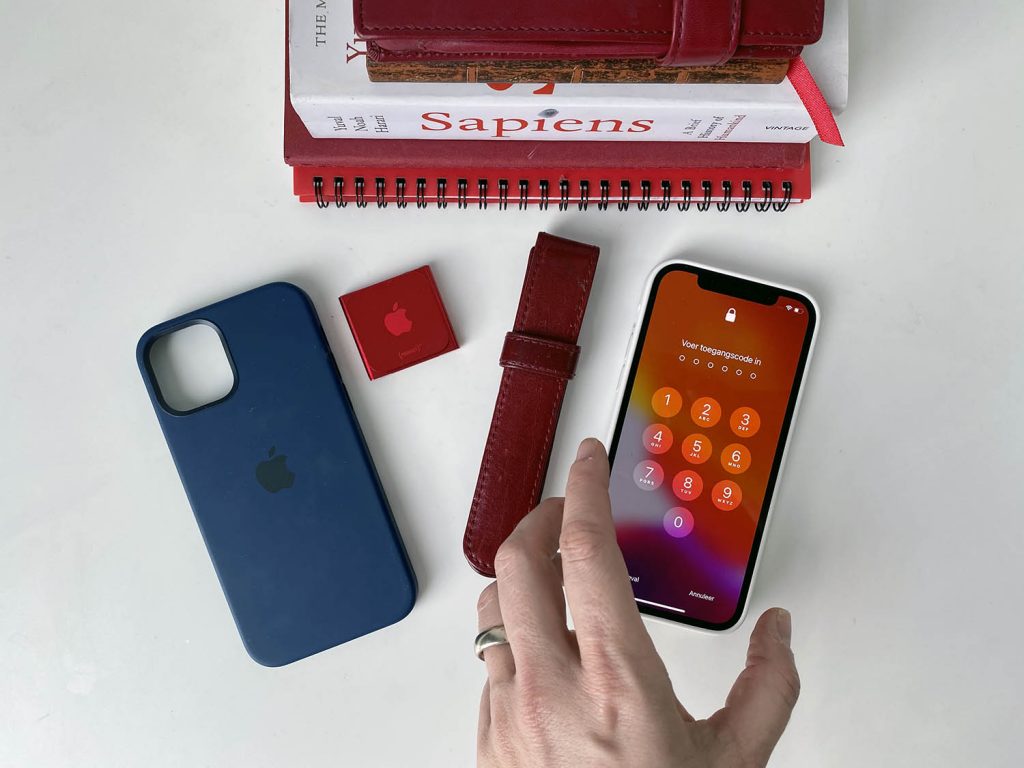
Design iPhone 12 Pro
- New squarer design with flat edges
- Weight 189 grams
- Dimensions 146.7 x 71.5 x 7.4 mm
- Four colors: ocean blue, graphite, silver and gold
- Water resistance IP68 (30 minutes at a depth of 6 meters)
The iPhone 12 Pro has a completely new design, which goes back to the much-loved iPhone 4 and 5 series and to the iPhone SE . Instead of the many curves of the iPhone 11 series, almost everything is now flat. The new design is very popular with us, as you could already read in our first impression of the iPhone 12 (Pro) . Because your fingers touch a larger surface, you have a bit more grip. Nevertheless, Apple has made some adjustments compared to the iPhone 4 and 5: because the devices are thinner and have narrower screen edges, it looks a lot more elegant. The flat side has allowed Apple to print the CE mark on it so it is not on the back. It is now slightly less noticeable, especially on the shiny edges of the Pro.
Another problem immediately arises when holding: the shiny edges of the iPhone 12 Pro look nice in marketing photos, but in practice they are quite sensitive to finger marks.
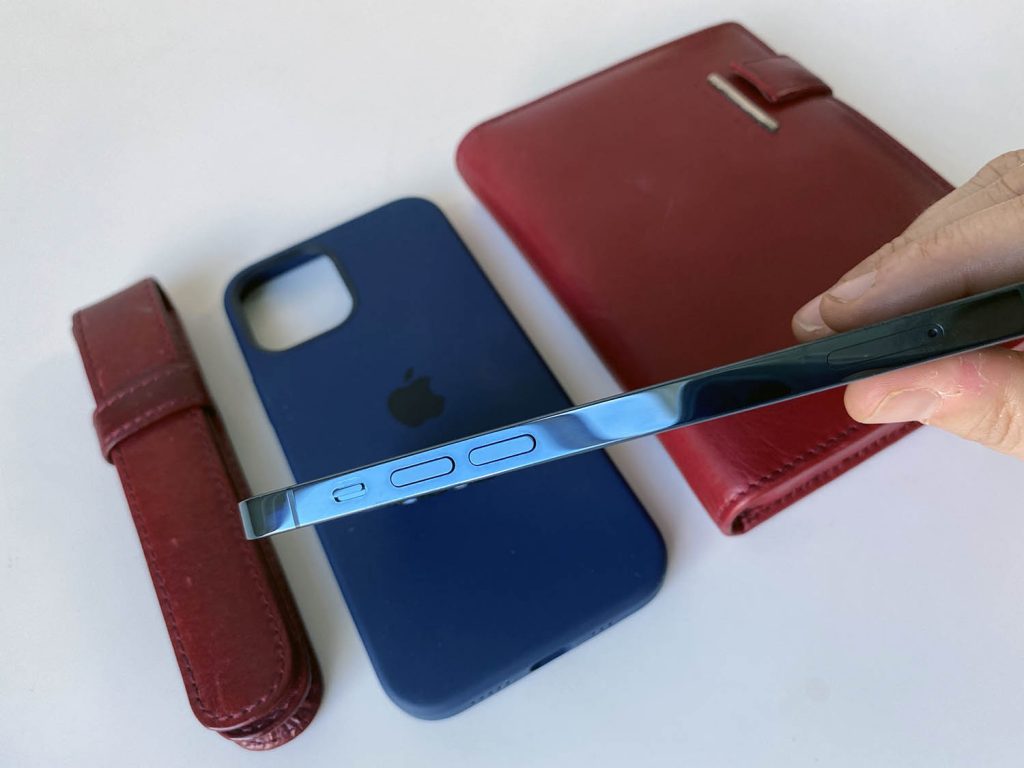
With the regular iPhone 12 you do not have that problem, because the edges are made of matt aluminum. But that model has a shiny back that is stain sensitive. We would prefer to see a completely matte housing. But Apple wants to emphasize the beautiful shine of polished steel with the iPhone 12 Pro. To be honest, it leaves me a bit cold in practice. I myself chose the Pro because of the extra functions, not because of the more luxurious appearance, because I often use a case.
To emphasize that luxurious look even more, Apple has again opted for subtle yet attractive Pro colors this year: graphite, silver, gold and ocean blue. I compared all the colors in the Apple Store and the new ocean blue color appealed to me the most. The hue changes from light to a darker blue, depending on the incidence of light. Still, I would have preferred a more pronounced dark blue, like the inside of the Apple’s silicone case for iPhone 12. For a brighter shade of blue you can go to the iPhone 12, but then you will miss a few extras. More on that later.
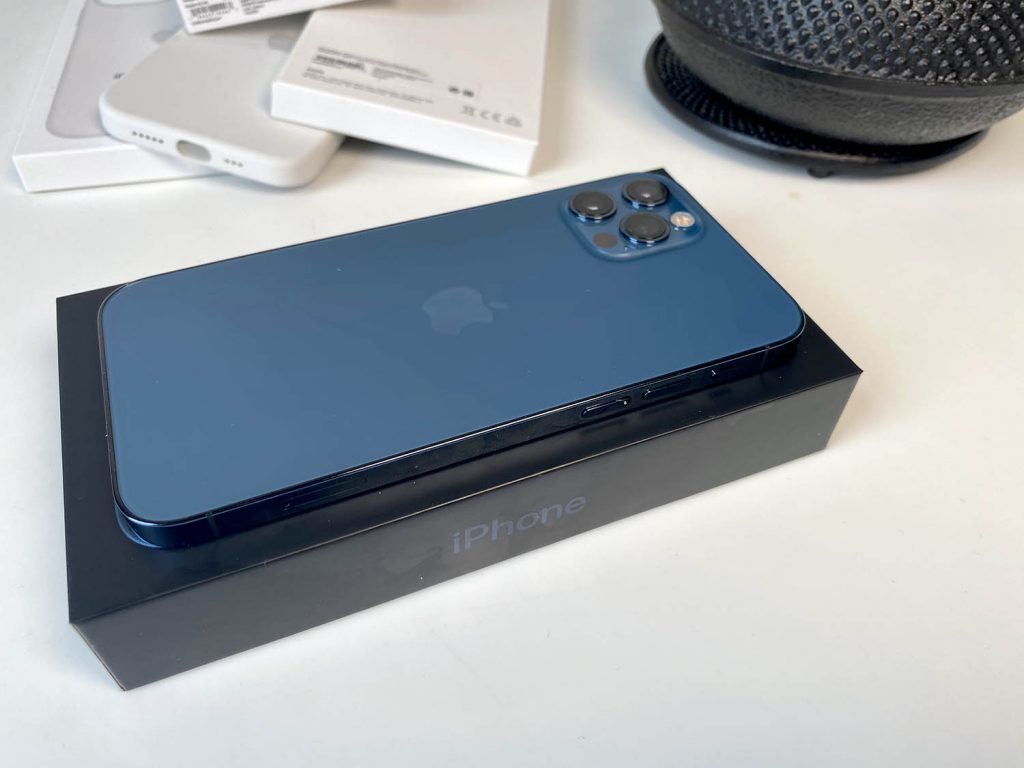
All in all, we are enthusiastic about this new design. The iPhone 12 Pro knows well how to find the balance between size and comfortable hold. Still, we miss something. When these devices were already in development months ago, Apple probably did not see the corona crisis coming. Nevertheless, we would have liked to see a solution to the mouth masks problem, for example the processing of Touch ID in the power button, as is done with the latest iPad Air.
Screen of the iPhone 12 Pro
- 6.1-inch Super Retina XDR screen
- 2532 x 1170 pixels (was: 2436 x 1125)
- Pixel density 460ppi
- Front protected by Ceramic Shield for better drop resistance
- Maximum brightness 1,200 nits for HDR video, 800 nits for normal use
This year, 6.1-inch is the standard format. I previously used the 6.5-inch iPhone 11 Pro Max and got used to the somewhat more compact size of this device. The screen is large enough to read, while the device is still nice and handy. An excellent format.
I informed people who previously used the 5.8-inch iPhone 11 Pro how they experienced it. It sometimes took some getting used to, but in the end the larger screen size is good. As long as Apple doesn’t make the device even bigger. Compared to the 6.1-inch iPhone 11 , the new iPhone 12 is slightly more compact. In that respect, Apple still has some expansion options, by making the bezels a bit narrower in subsequent generations.
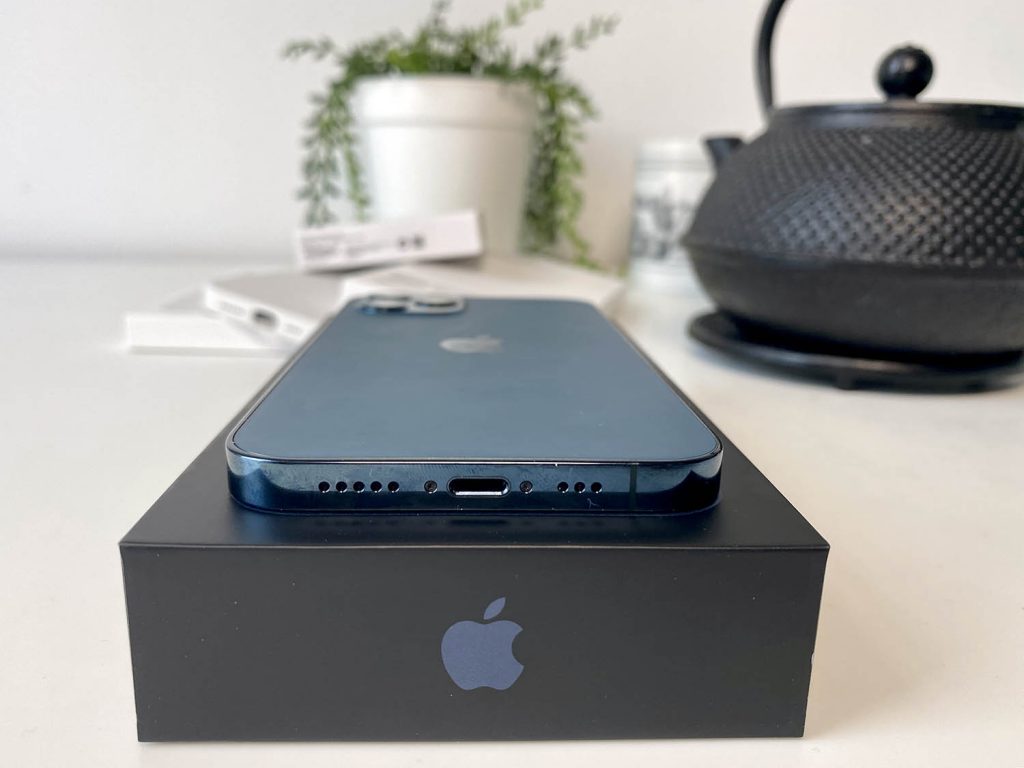
The step from 5.8-inch to 6.1-inch hardly affects the amount of pixels (from 2436 x 1125 to 2532 x 1170 pixels) and the pixel density has also remained almost the same (from 458ppi to 460ppi). The changes to the standard iPhone 12 are a lot bigger: the switch from LCD to OLED was made for the first time and the pixel density has gone from just 326 ppi to 460 ppi – a huge step!
The fact that the two mid-range models are now 6.1-inch, makes the range a lot clearer in any case. The default choice is 6.1-inch, with a choice of Normal and Pro. Those who want bigger will pay more, those who want smaller will pay less. It all sounds very logical.
Apple has not opted for a ProMotion screen with a 120 Hz with the Pros, with which you can scroll more smoothly. We think that is a missed opportunity. It probably has to do with battery life or with components, but this is where the Pro could really have differentiated itself from the standard model.
The glass at the front is now completely flat, while on previous models it curved nicely to the back. Incidentally, this does not result in narrower screen edges: they are still clearly present at 3mm. The notch has become slightly smaller: it now measures approx. 34mm at its widest point, while it used to be approx. 36mm.
The fronts of all iPhone 12 models are now made of Ceramic Shield , a new type of glass reinforced with nano-ceramic crystals and developed in collaboration with Gorilla Glass manufacturer Corning. The first scratch and fade experiments show that the glass is indeed damaged less quickly, but it is still not indestructible. Despite the grease-resistant coating, it is still sensitive to finger stains. However, I will still continue to use a case, simply because I drop my device from my hands once a week on average. Cases like Apple’s and Mujjo’s have saved me time and time again, and Apple’s marketing talk about Ceramic Shield hasn’t convinced me I can live without it now.
Ceramic Shield does not change the appearance of the screen. It is just as easy to read and the color rendering is comparable. The scratch sensitivity is also the same. With my iPhone 11 Pro Max , after a year of use, there are still a few noticeable, but not disturbing, scratches on the screen. Apple gives the impression that Ceramic Shield mainly protects against drops and less against scratches. Those who want to be sure, take a screen protector.
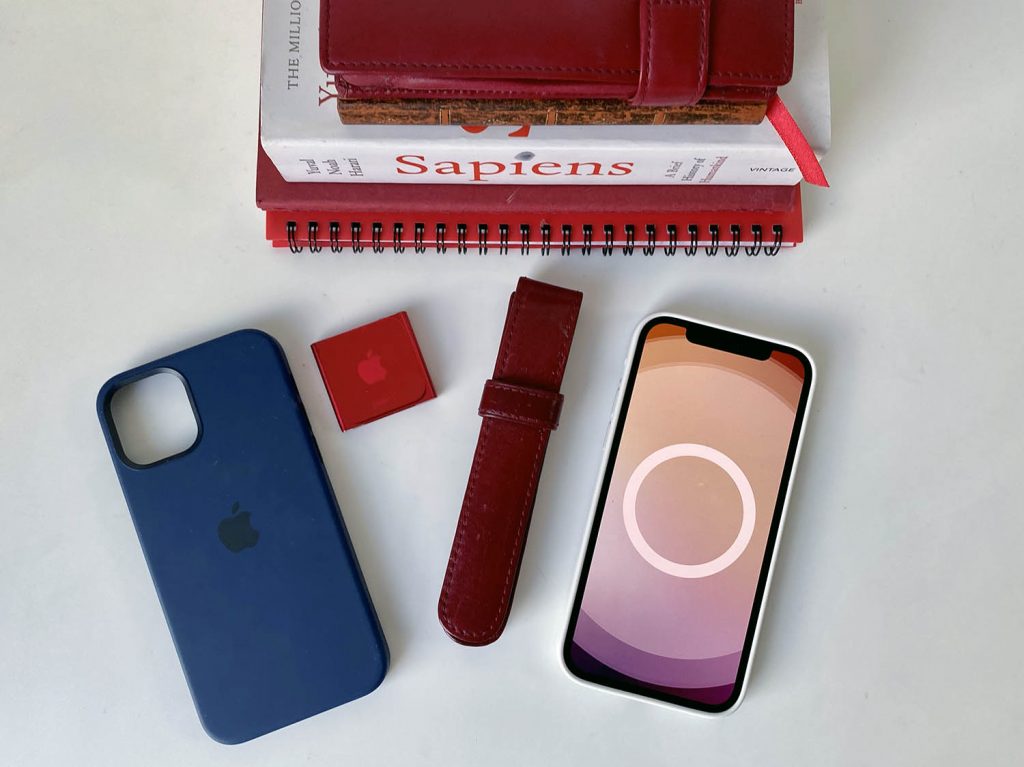
Apple opts for an OLED screen in all models this year . On the one hand, that is a good development, because the cheaper models now also have a nicer screen. But it does nibble on the high-end status of the Pro models a bit. If everyone now gets an OLED screen, why would you choose the Pro? This eliminates one of the most important buying arguments for the Pro model. That problem affects more features in the iPhone 12 family: there are so many similarities that it is still difficult to convince someone to get an iPhone 12 Pro.
In fact, the only difference is that the iPhone 12 has a maximum brightness of 625 nits in normal use, while the Pro with 800 nits is slightly higher. Both devices have a maximum brightness of 1,200 nits when playing HDR video, so at this point they are the same again. On both devices, the OLED screens are quite bright and show realistic colors and dark blacks, with a contrast ratio of 2,000,000: 1. The viewing angle is also fine.
Perhaps next year Apple can give more distinction to the displays of the Pro models and the standard versions. There are still rumors about a ProMotion display, with a higher refresh rate. This year that is not possible and we think that is a shame.
Hardware: the fast processor goes without saying
- A14 Bionic processor
- Neural Engine with 16 cores
- Minimum 128GB of storage
The fact that the iPhone 12 series is the most powerful yet is a clincher. Of course, the A14 Bionic is again faster and more powerful this year than that of previous years. And that was very quickly. As iPhone users, we take advantage of the enormous lead Apple has in the field of processors by developing everything in-house. Apps start up smoothly as before. Fortunately, Apple has used that extra power to do some extras, such as filming in Dolby Vision HDR 4K, without draining your battery immediately.
The price of the entry-level model of the iPhone 12 Pro has remained the same this year: € 1,159. But you do get more for your money, namely twice the storage. Instead of 64GB, Apple now supplies the iPhone 12 Pro with at least 128GB and rightly so. Many people felt compelled to spend some extra money for the model with more storage in previous years, because 64GB is simply too little for a Pro user. Especially if you plan to use your device a little longer.
5G connectivity
- Standard on all iPhone 12 models
- European iPhone 12 models only offer Sub-6 support
- Works with 5G networks
The biggest innovation, according to Apple, is the 5G function. During the announcement, a lot of emphasis was placed on this, although we notice that it is not really playing for many people. This also has to do with the fact that the 4G networks in the Netherlands are very good – in contrast to, for example, Germany, where the expansion of 4G is still not completely finished. Perhaps that is the reason why the enthusiasm for 5G in the Netherlands is not that great yet. We would like to have it in our devices (and preferably the mmWave variant, which is not yet available in the Netherlands), but it is more a nice certainty for the future than that people are already yearning for faster internet.
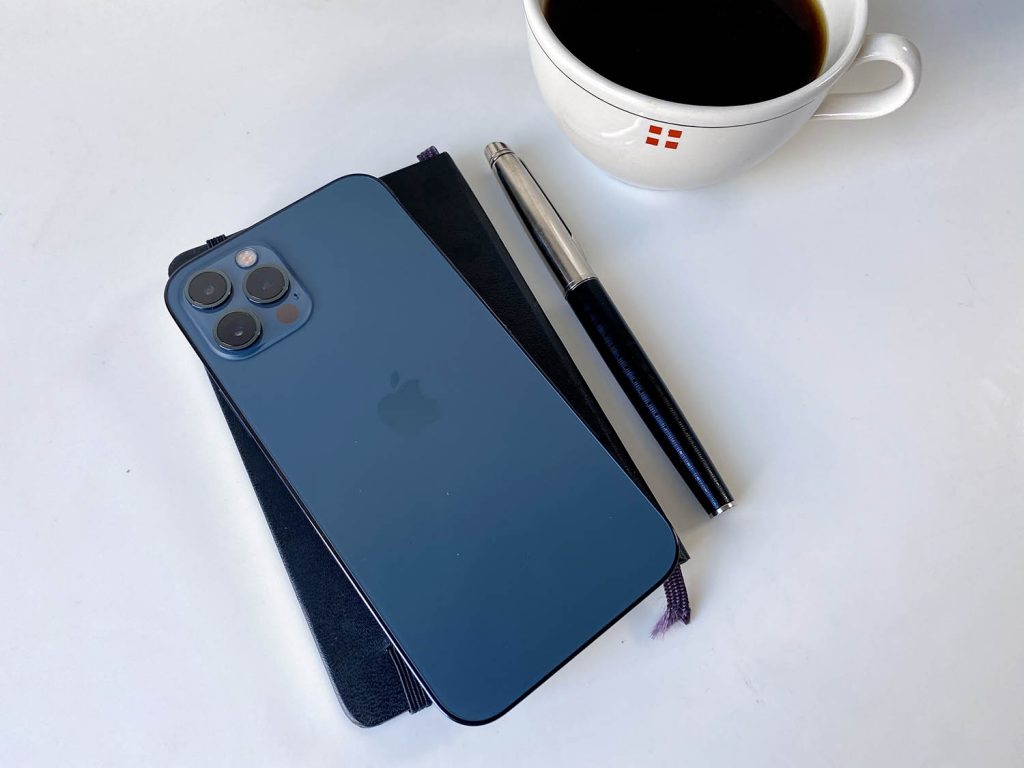
Smart is that Apple only switches on 5G when it is really needed, thanks to the Smart Data function. You therefore do not have to worry about it and you know for sure that 5G will not drain your battery unnoticed. We find it less convenient that it is never entirely certain which network you are on. Apple would show the best available network in your location, not the network you are actually connected to. It happened regularly that 5G was showing in the status bar, while I was not doing anything with my iPhone and had the option 5G Auto turned on. When you need to perform an urgent action, you have to rely on Apple’s algorithms or choose to keep 5G on all the time – but that costs more battery .
If you do, and if you achieve an average speed of 300 Mbps like we do, you can download files of several gigabytes in a few minutes. Here is some Netflix download data:
- SD: approx. 1GB data per hour of video
- Full HD (1080p): approx. 3GB per hour of video
- 4K Ultra HD: Approx. 7GB per hour of video
Would you achieve the theoretical maximum speed of 1Gbps on Vodafone 5G, then you can download a complete movie in a few seconds. With us it took a little longer because of the slightly slower speed that you achieve in practice, but you can at least watch the film within a minute. Downloading via Wi-Fi is still possible, but is no longer necessary at these speeds. Great of course, but… how often do you really need this? Maybe a few times a year, just before you get on a plane? Could be, but now that everyone is at home continuously, the need is much less.
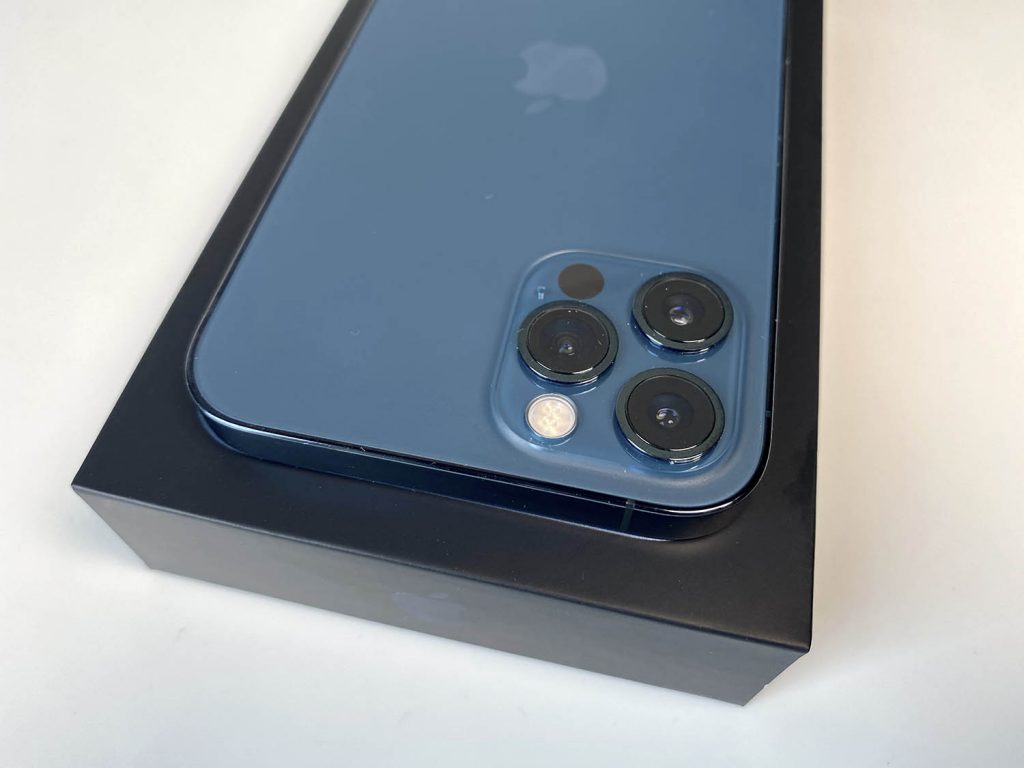
Camera of the iPhone 12 Pro
- Three camera lenses on the back:
- Wide angle: 12 megapixels, f / 1.6, OIS
- Telephoto: 12 megapixel, f / 2.0, OIS, 2x optical zoom
- Ultra-wide angle: 12 megapixels, f / 2.4
- LiDAR Scanner
- 12 megapixel front selfie camera
- Video films with Dolby Vision
So far we have mainly discussed features that you also find in the regular iPhone 12. However, the camera is a different story. This is significantly better with the iPhone 12 Pro and has unique features that you will only find on this device. Still, the iPhone 12 Pro is still not the ultimate when it comes to the camera. If you really want to get the most out of it, you better wait for the iPhone 12 Pro Max, which scores just a little better in terms of camera specs. That is why we briefly discuss the subject of the camera in this review and go all out with the camera functions in our upcoming review of the iPhone 12 Pro Max .
Photography has always been an important topic for Apple. Every year the camera is tinkered with and everything is made even better and smarter. This year you get night mode and HDR on all rear and front camera lenses. Apple does not participate in the megapixel race and again opts for 12 megapixels, while at the same time throwing more hardware and software tricks to make your photos look better. In our opinion, an excellent choice. As a result, your daily photos take up little space and still look fine. Those who want more during special moments can opt for ProRAW for the first time this year , which gives you more editing options afterwards.
At first glance, the camera bulge looks the same as last year, but the lenses have been improved on a number of points. With the Pro you get 2x optical zoom and 10x digital zoom, just like last year. If you want to zoom in more without loss of quality, then you need the Pro Max.
As you can see in the test photos, the colors come out well and you also get a nice effect in portrait mode. HDR ensures that parts of the photo that are a bit darker also show a lot of detail. And in portrait mode, we noticed that the camera is now better able to separate the object from the background, resulting in less woolly edges. This is no doubt thanks to the LiDAR Scanner, which you will only find on the Pro models. The camera is therefore better able to see depth, even when taking portraits in the dark. Thanks to LiDAR, the camera also focuses more quickly on the object – useful if you want to capture that one exciting event quickly.
All cameras are now equipped with Night Mode, so that your selfies also come out well in low light. In addition, I noticed that photos taken in twilight are sharpened a bit too much for my taste. It is not disturbing, but it clearly shows that Apple is adjusting the image and trying to make it more beautiful than what your eye sees.


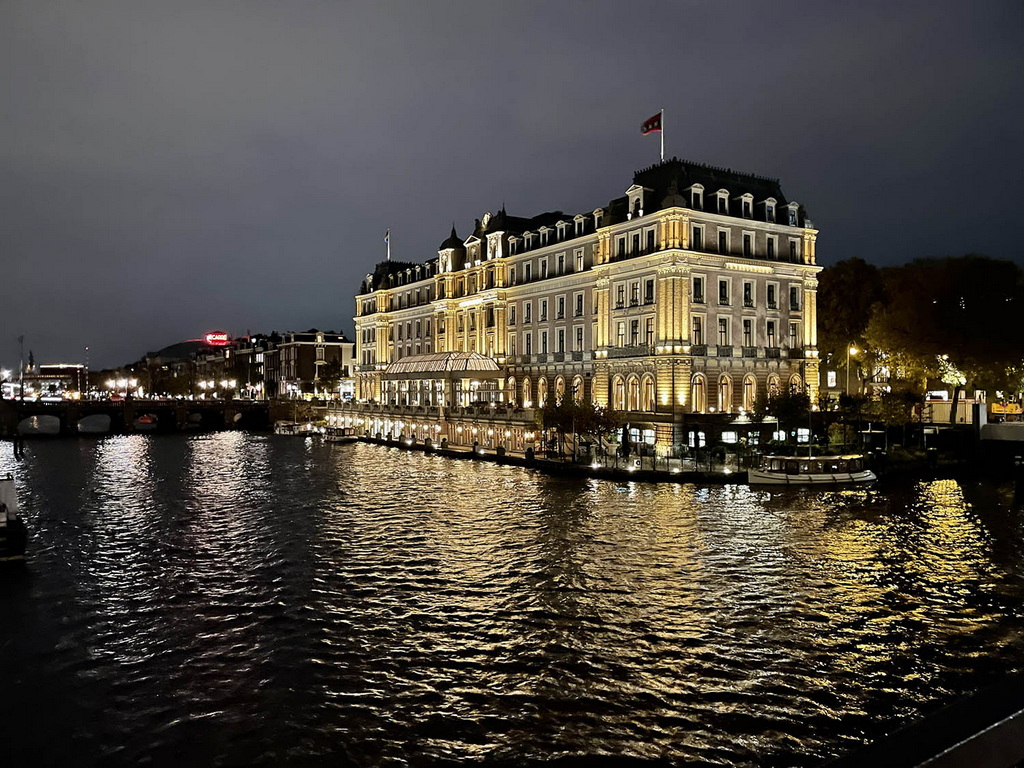
People who like to film video with their iPhone can get started with Dolby Vision with the iPhone 12 Pro. This works on all four cameras. The result is a video that can look very smooth and professional if you put a little effort into it. We applaud that Apple has chosen Dolby Vision and not 8K video, as Samsung and Xiaomi have done. Video filming in 8K has quite a few limitations: with the Samsung Galaxy S20, you can only film video in 8K for a maximum of five minutes, otherwise overheating will occur. Dolby Vision HDR is a much more useful addition as it produces nicer images that you can play on any 4K television and not just a higher resolution with files of gigantic size, for which you need an 8K television. Dolby Vision makes the colors more realistic with enough detail – and that’s what you want.
What we noticed during filming is that the image stabilization is very good. And although we are not professional videomakers ourselves, we can imagine that with this device it is even better to make a commercial or short feature film and it is certainly good enough for most vloggers and YouTubers in terms of image quality.
Ultimately, the choice between iPhone 12 and iPhone 12 Pro is mainly about how much control you want over the camera. The cameras have been greatly improved on both devices, but the Pro gives you just a little more options. If you want everything to be automatic, the regular iPhone 12 is enough, which also has smart recognition of scenes based on machine learning. The camera therefore knows whether you are taking a picture of your dog or a landscape and adjusts the settings accordingly. There is a lot of calculation involved, but the iPhone takes care of that for you. All four models feature the same fast A14 Bionic chip with Neural Engine.
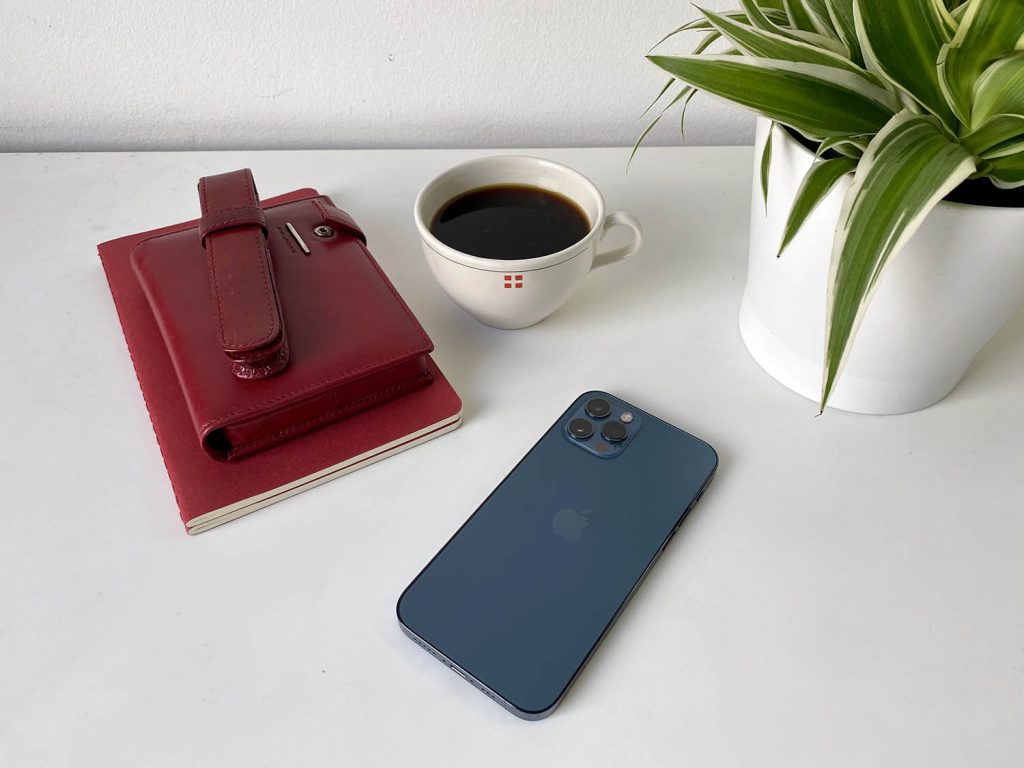
Battery life
- Same battery life as last year
- New: charging with MagSafe
- No power adapter included (but a cable)
We actually find it a bit problematic that no power adapter is included anymore. Apple hides behind the argument ‘environment’, but forget one thing: many people do not yet have a USB-C charger at home. If you skipped the iPhone 11 Pro last year, this is your first iPhone with a USB-C cable, but you can only use it if you purchase an adapter for an additional 25 euros.
We would have preferred that Apple included the adapter as an option, for example by charging € 10 extra for it. Now the user is saddled with a problem. Apple will get away with it again, but sympathetic is different.
Of course you are not completely taken aback: you can still charge the iPhone 12 with a Qi charger, with the old Lightning cable and current plug or by connecting the USB-C cable to the MacBook. But also with MacBooks, not everyone has switched to USB-C yet.
Battery life is less than usual at the moment, as most people sit at home with an outlet an arm’s length away. We hardly travel and the slightly more energy-consuming 5G will also have little impact if people spend most of their time at home on a Wi-Fi network. We easily managed a full day, without having to recharge in between. We did not notice any difference with last year’s devices.
The battery life that Apple promises for different scenarios is usually correct and we have therefore mainly put our energy into another matter: charging. MagSafe in particular still raises many questions: is it faster than charging via a cable, what should the wattage of the adapter be? To answer this, we performed an extensive iPhone 12 charging test , in which we measured different scenarios.
By the way, this will not completely overcome your headaches, because if you are used to using a case, you will have to make sure that it is a MagSafe-compatible one. For example Apple’s own MagSafe silicone case , which we reviewed. You can also buy a case that participates in the new MFi program for MagSafe accessories, but you will pay an ‘MFi tax’. Or you choose a case that is extremely thin, so that it does not get in the way of the magnets. A big advantage of MagSafe is that you use the iPhone can continue to use while charging, because it sticks to your device. This is always a problem with normal wireless charging: as soon as you pick up the iPhone to read the screen, the charging stops. It also means that you can’t just take your iPhone off the charger: the magnets make it stick, so you’ll have to pull the charger off with some force.
The iPhone still has a Lightning connector on the bottom and that doesn’t seem to change that quickly.
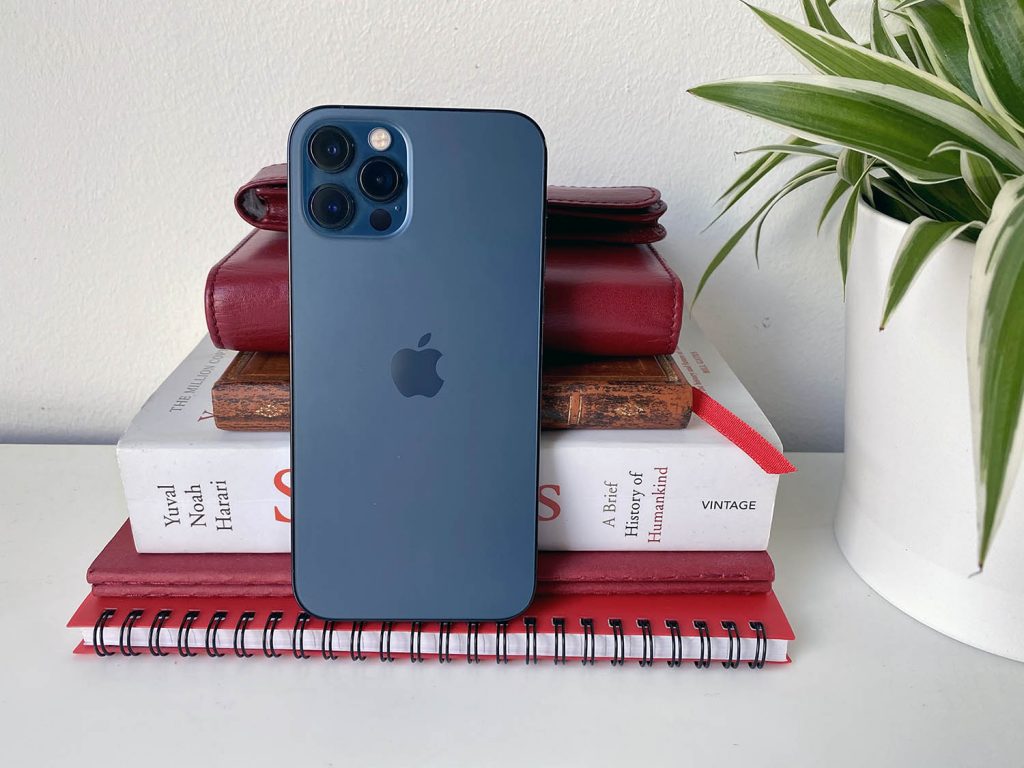
Who is the iPhone 12 Pro for?
The main competitor of the iPhone 12 Pro can be found in-house: it is the regular iPhone 12. It is made of less luxurious materials, but offers the same performance, 5G function, screen and many other functions for a lower price. When it comes to the camera, you have to give up something. But it is precisely because of that camera that the iPhone 12 Pro is in a somewhat unpleasant middle position. Those who really want to get the most out of the camera prefer the larger iPhone 12 Pro Max.
If you spend another € 100 extra, the iPhone 12 Pro Max will give you a larger screen, a larger camera sensor and a new sensor-shift stabilization system that we are very curious about. This device will be on the market in mid-November.
Yet there is a target group for the iPhone 12 Pro, namely the group of people who see themselves as Pro users and who faithfully switch to the next Pro model every year (or every two years). The size is also important: it still has to remain a good handy device and that is the case with the 6.1-inch variant.
Conclusion iPhone 12 Pro review
The iPhone 12 is clearly a Pro device. This time the camera offers even more options and the finish looks luxurious. Nevertheless, we cannot escape the impression that the regular iPhone 12 is actually sufficient for many people. Many features are the same: the screen, the processor, the 5G function and even the size. It is therefore more difficult than ever to decide which of the two to choose. There will be people who are happy to pay an extra 250 euros for the Pro experience. But that will not apply to everyone.
Another critical point is that with 5G, LiDAR and MagSafe there are a lot of nice functions that you cannot do much with at the moment. MagSafe is cleverly designed and works very well, but you can now only buy a case and a charger. The really nice applications are still waiting. The same goes for 5G and LiDAR: reassurance for the future that it is in it, but for now you will not use it that much. When everyone is at home, there is less need for 5G and there are few applications for LiDAR.
We are especially happy with the improvements in the field of the camera and that will also be the main reason for choosing this Pro. However, if there is still some room in your budget and you can show the patience, you could also wait for the iPhone 12 Pro Max , which has an even better camera. Ultimately, it is mainly a matter of size: the iPhone 12 Pro is intended for people who want Pro, but who do not like the extra large Pro Max.
BENEFITS
- Luxurious appearance with steel edges
- Fast A14 Bionic processor
- 5G support
- Faster wireless charging with MagSafe
- All kinds of MagSafe accessories
- Greatly improved camera including Dolby Vision and 4K HDR
CONS-
- Edges are prone to smudging
- Many features that you also find on the cheaper iPhone 12
- MagSafe accessories are expensive
- For faster charging, you need to purchase all accessories yourself
- Does not offer a solution for mouth caps, eg Touch ID in side button
- Relatively few Pro features to justify the purchase
- No 120Hz screen
